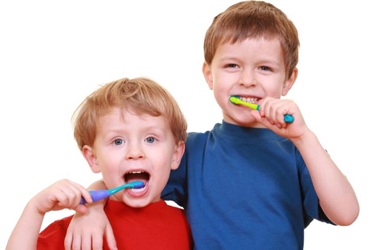Tons of future responsibilities can run through your head as you hold your newborn in your arms. But keep in mind that eventually, your child will experience teething symptoms. Teething occurs when the "baby teeth" erupt through the gums, and it's a normal part of infant development. The teeth start to emerge throughout the gums when the baby is approximately six to 10 months old, according to the American Dental Association (ADA) Mouth Healthy site, although it can occur before or after these ages as well.
Teething Symptoms
Children are usually around three years old when they should have their full set of 20 primary teeth. The bottom two front teeth should erupt first, followed by the two upper front teeth, and any of them can cause irritation to the gum tissue. For some infants, teething can bring mild symptoms that just last a few days. For others, symptoms can be quite painful and last much longer. The side-effects of teething can occur over the course of a few days, or even weeks, before the tooth comes through the gumline.According to the ADA, common symptoms and signs include:Red and swollen gumsRefusal to eatDrooling more than usualWaking up more at night or restlessnessWanting to bite or to chew moreSoothing IrritationTo offset some of the discomfort, gently rub the gumline with a clean finger to ease the pain. Many parents find that allowing their kids to bite on a clean and cool object is soothing (for example, a chilled teething ring), and can be helpful too. However, avoid placing anything but water in a baby's bottle when putting the baby to bed.
Beginning Oral Care
Even before the first tooth erupts, start to clean your baby's gums with a soft washcloth. Make sure that any plaque or food debris is wiped away twice a day for optimal mouth care. Once that first tooth pokes through, products such as My First Colgate™ infant and toddler toothpaste contain a gentle, mild flavor that can assist in the beginning of daily oral hygiene. It is geared toward children up to two years old, and it is safe if swallowed. Use just a small rice size amount on a soft infant toothbrush that's designed for small mouths.Visiting the DentistAt the age of one, parents can begin to bring their baby to the family dentist, or to a pediatric dentist to ensure that proper dental care starts early and is a pleasant experience. Your search for a pediatric dentist can begin with a referral from a friend or neighbor, or you can use the ADA to locate a pediatric dentist near your home.
Nutrition for a Great Smile
To ensure that your child has a balanced and varied diet, make sure to include servings of fruits, vegetables, breads and cereals, milk and dairy products – as well as meat, fish and eggs for protein and to help develop his or her tastes. Try to limit foods with excessive sugars to further protect your child's teeth from decay. Remember that your pediatric dentist is also there to help you select foods that protect your child's new teeth.Throughout the process, make sure that your baby gets plenty of rest for proper growth and infant development. Together with regular dental visits and a balanced diet, you can ensure that your child will possess good oral habits and a healthy smile to last a lifetime.About the author: Diana Tosuni-O'Neill is a licensed registered dental hygienist in New York and New Jersey with over 25 years of clinical experience in dental hygiene practice. She was employed for over 15 years with the team dentist for the sports teams the New York Giants, the Brooklyn Nets and the New Jersey Devils. Diana is also an ACE Certified Personal Trainer and a Group Fitness Instructor. Her passion for the dental and fitness fields spans over two decades. She is also a freelance writer specializing in oral health care. She enjoys traveling, gardening, decorating and her fitness workouts. Diana presently resides outside Manhattan with her two children.
Source: How Teething Fits into Infant Development
Source Link: http://www.colgate.com/en/us/oc/oral-health/life-stages/infant-oral-care/article/sw-281474979346501












